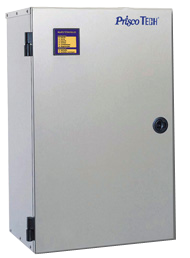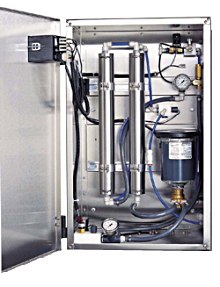PriscoTech® AquaFlo® II Water Processing System

Your incoming water supply varies due to seasonal changes and chemicals added by local water suppliers. The PriscoTech AquaFlo II Water Processing System supplies you with process water designed for the printing process, helping you manage the complex ink, paper and water interactions on your press. Whatever your incoming water’s characteristics, the AquaFlo II will transform it into the required starting point for your press chemistry.
The AquaFlo II generates process water through a unique combination of the latest membrane and particulate filtration techniques, carbon adsorption and chemical component stabilization technologies. Your incoming water is processed in a multi-stage pre-filtration module, and then moves into the core water processor. Our exclusive post-treatment process acts to stabilize the water before it is stored in a process water storage tank. The re-pressurization pumping system moves the water into your blending system or onto your press.
Models available and production capacities * :
- AF300 – 300 gallons (1136 liters)
- AF600 – 600 gallons (2271 liters)
- AF900 – 900 gallons (3407 liters)
- AF1600 – 1600 gallons (6056 liters) (3407 liters)
* Incoming water 77º F (25º C), actual output may vary, depending on local water conditions.
AquaFlo II System Benefits
- Consistent process water, with characteristics that you can count on, day in and day out. To better manage the printing process, you need this stable platform for your press chemistry.
- You’ll eliminate variability in your pH and conductivity levels.
- Achieve faster make-ready for your press, with the dependability of process water.
- Improve quality with better ink/water balance, which helps you minimize fountain solution and ink usage. You’ll also reduce your dependence on chemical additives that you’ve used to solve printing problems.
- Reduce blanket piling, ink feedback and paper waste.
- Eliminate scaling, mineral deposits, and clogging of nozzles in water and dampening systems.
- Avoid roller stripping by reducing the solids that hard water can deposit on ink rollers and cylinders.
- Extend plate life by removing the calcium and magnesium salts that are deposited on plates by hard water.
- Reduce alcohol consumption and promote alcohol-free printing.
- Prevent bacterial growth in the dampening system by removing microbiological organisms from your incoming water supply.



